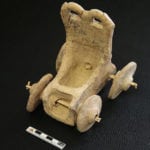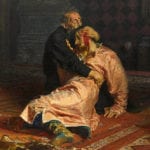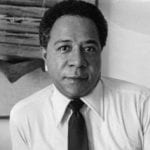 Technology
Technology  Technology
Technology  Humans
Humans 10 Everyday Human Behaviors That Are Actually Survival Instincts
 Animals
Animals 10 Animals That Humiliated and Harmed Historical Leaders
 History
History 10 Most Influential Protests in Modern History
 Creepy
Creepy 10 More Representations of Death from Myth, Legend, and Folktale
 Technology
Technology 10 Scientific Breakthroughs of 2025 That’ll Change Everything
 Our World
Our World 10 Ways Icelandic Culture Makes Other Countries Look Boring
 Misconceptions
Misconceptions 10 Common Misconceptions About the Victorian Era
 Mysteries
Mysteries 10 Strange Unexplained Mysteries of 2025
 Miscellaneous
Miscellaneous 10 of History’s Most Bell-Ringing Finishing Moves
 Technology
Technology Top 10 Everyday Tech Buzzwords That Hide a Darker Past
 Humans
Humans 10 Everyday Human Behaviors That Are Actually Survival Instincts
 Animals
Animals 10 Animals That Humiliated and Harmed Historical Leaders
Who's Behind Listverse?

Jamie Frater
Head Editor
Jamie founded Listverse due to an insatiable desire to share fascinating, obscure, and bizarre facts. He has been a guest speaker on numerous national radio and television stations and is a five time published author.
More About Us History
History 10 Most Influential Protests in Modern History
 Creepy
Creepy 10 More Representations of Death from Myth, Legend, and Folktale
 Technology
Technology 10 Scientific Breakthroughs of 2025 That’ll Change Everything
 Our World
Our World 10 Ways Icelandic Culture Makes Other Countries Look Boring
 Misconceptions
Misconceptions 10 Common Misconceptions About the Victorian Era
 Mysteries
Mysteries 10 Strange Unexplained Mysteries of 2025
 Miscellaneous
Miscellaneous 10 of History’s Most Bell-Ringing Finishing Moves
10 Early Versions Of Famous Works Of Film
One of the most common complaints about Hollywood today is that there are too many unnecessary remakes, many of them based on movies which were perfectly fine to begin with. However, taking a good idea and finding a way to improve upon it is another matter. Sometimes, artists just do not have the budget and resources to do everything they want with their ideas the first time around. But when given another opportunity, these artists have taken early, smaller-scale versions of their ideas, and turned them into legendary works of pop culture.
10Jim Henson Used Some Of The Muppets In IBM Training Films
After being showcased on Sesame Street and being given their own vehicle with The Muppet Show, Jim Henson’s Muppets became some of pop culture’s most beloved characters. However, many people don’t know that the most famous Muppet of them all, Kermit the Frog, has actually been around since the 50s. Kermit made his first official appearance on Sam and Friends, a children’s puppet television show created by Jim Henson in 1955. Over the course of the next decade, Henson would use some of his future Muppet characters (primarily Kermit and Rowlf the Dog) in any project he could find, whether it was commercials or skits on late-night talk shows. However, the Muppets’ most unusual appearances was probably in training films for IBM.
In 1966, Henson was contracted by IBM to put together four short films for the company. These films showcased early incarnations of Kermit and Rowlf. Some of the shorts were intended as icebreakers for business meetings, while others featured the Muppets demonstrating IBM’s products in a humorous fashion. One short is also notable for featuring the very first appearance of the Cookie Monster, who eats a coffee machine and winds up exploding.
9The Simpsons Started Off As Animated Shorts On The Tracey Ullman Show
The very first feature-length episode of The Simpsons aired on December 17, 1989 and new episodes continue to be produced almost a quarter of a century later. It’s amazing to think how the show became such a global pop culture phenomenon, especially when you remember its very humble beginnings. In 1987, producer James L. Brooks was working on the Fox-produced comedy series, The Tracey Ullman Show, and decided that he wanted to pad out each episode with some short animated interstitials. Brooks was a fan of cartoonist Matt Groening and his comic strip series, Life in Hell, and intended to do an animated version of those comics.
However, since Groening did not want to give up the publication rights to Life in Hell, he decided to come up with a new idea, about a dysfunctional family named the Simpsons. The characters were named after and loosely based on Groening’s own family and he practically dreamed up the whole thing while waiting in the lobby outside Brooks’ office. These crudely animated sketches were voiced by cast members from The Tracey Ullman Show and, after they drew a positive response, Fox eventually decided to turn The Simpsons into its own animated series. The rest, as they say, is history.
8Sam Raimi’s Original Version Of The Evil Dead Was A Short Film Called Within The Woods
In 1981, a young Michigan director named Sam Raimi made an ultra-gory low-budget horror film called The Evil Dead, the story of five college students who visit an abandoned cabin in the woods and wind up being possessed by demonic spirits. The film toured the festival circuit for a while, and after garnering strong word-of-mouth (including a ringing endorsement from Stephen King), it was able to secure distribution and become a cult hit. The Evil Dead spawned two sequels and Bruce Campbell’s wisecracking hero, Ash, wound up becoming one of the most popular horror movie characters ever. However, the series’ success was made possible by a 32-minute short film called Within the Woods.
Three years beforehand, Raimi and his friends decided to shoot Within the Woods on Super 8 film with a budget of $1,600. The short featured the same premise as The Evil Dead and pretty much functioned as a prototype for a feature-length horror film Raimi wanted to make. The director hoped he could use Within the Woods to secure funding from investors. After screening his short film in local cinemas, Raimi was eventually able to raise $90,000 to produce The Evil Dead. Incidentally, Bruce Campbell also had a role in Within the Woods, but his character was named Bruce, not Ash. And instead of functioning as the story’s hero and surviving until the very end, Bruce actually winds up turning into a demon and gets dismembered!
7Paul Thomas Anderson’s Boogie Nights Started Off As A Mockumentary
One of the most acclaimed films of 1997 was Paul Thomas Anderson’s Boogie Nights, an epic chronicle of the pornography industry during the 1970s and early 1980s. Mark Wahlberg played the film’s protagonist, a well-endowed kid named Eddie Adams who finds fame as a porn star named Dirk Diggler, before spiralling into drug addiction. The character was based on the famous porn actor, John Holmes, but Dirk Diggler actually made his first appearance in a project Anderson had directed nine years beforehand.
In 1988, the 17-year-old Anderson decided to make The Dirk Diggler Story, a 30-minute “mockumentary” about the life of its title character. He shot the whole thing on videotape and used two VCRs to edit it together. Much like in Boogie Nights, a well-endowed kid named Steven Samuel Adams becomes a famous porn star and changes his name to Dirk Diggler, until a serious drug addiction leads to his downfall. Anderson’s main inspiration was a documentary he had seen called Exhausted, a self-indulgent vanity project about John Holmes, which painted him as an iconic, larger-than-life figure and glossed over his self-destructive tendencies. The Dirk Diggler Story was intended as an over-the-top parody of the Holmes documentary and Anderson garnered a lot of his humor by having his actors play the ridiculous material as seriously as possible. Rough early versions of characters and scenes from Boogie Nights can be seen throughout.
6Michael Mann’s Heat Is A Remake Of His Own Made-for-TV Movie
One of the most anticipated movies of 1995 was Michael Mann’s crime drama, Heat, as it would feature the first-ever scene between two of Hollywood’s greatest actors, Al Pacino and Robert De Niro. The story involves a cop named Vincent Hanna (Pacino) relentlessly pursuing a master criminal named Neil McCauley (De Niro) and the film’s most famous sequence features the rivals sitting down to have a cup of coffee together. Heat was a critical and commercial success, but few people knew that Michael Mann had already done a smaller-scale version of this story six years earlier. Mann originally wrote his 180-page screenplay during the 1980s and got his first opportunity to adapt it when he directed L.A. Takedown, a made-for-television movie which aired on NBC on August 27, 1989.
L.A. Takedown was originally intended to be a pilot for a TV series, but it never got picked up. While the two movies have numerous similarities, Mann was working with a much smaller budget on television, and had to cut down his script to 110 pages. Since Mann wanted to do a much larger, multi-layered version of his story, he eventually decided to remake his own movie. Mann had bigger stars and a lot more money to work with when he directed Heat, so he was finally able to make the three-hour crime epic he always wanted. Incidentally, the aforementioned coffee scene can still be seen in L.A. Takedown, but instead of Al Pacino and Robert De Niro, it features the A-list duo of Scott Plank and Alex McArthur!
5Seth MacFarlane Based Family Guy Off His Student Thesis Film
Seth MacFarlane’s animated TV series, Family Guy, is a prime example of a work of pop culture bring resurrected by its fanbase. The show was cancelled after airing on Fox for three seasons, but strong DVD sales led to it being brought back onto the air in 2005 and new episodes continue to be produced to this day. However, in 1995, long before Family Guy was even a thing, Seth MacFarlane was studying animation at the Rhode Island School of Design. For his thesis film, MacFarlane made a 10-minute animated short called The Life of Larry, where the early templates of Family Guy can be seen.
The title character is an overweight middle-aged slob named Larry Cummings, who is the obvious inspiration for Peter Griffin. Larry has a wife named Lois, an overweight teenage son (here named Milt instead of Chris), and his best friend is a cynical talking dog, named Steve instead of Brian. MacFarlane voiced most of these characters himself and much like Family Guy, The Life of Larry contains numerous pop culture references and random cutaway gags. This short earned MacFarlane his first major job at Hanna-Barbera Studios, where he would later be asked to make another short film with these characters, entitled Larry & Steve.
4Sling Blade Was the Continuation Of A 25-Minute Short Film
In 1996, Billy Bob Thornton became a star after an Oscar-nominated performance in the film Sling Blade. Thornton portrayed Karl Childers, a mentally impaired man who is forced to adapt to the outside world after spending 25 years in a mental institution for killing his mother and her lover. Thornton was also the director and writer of the film and took home an Academy Award for his screenplay. However, two years beforehand, Thornton was a relatively unknown character actor when he delivered his first portrayal of Karl in a black-and-white 25-minute short film.
Directed by George Hickenlooper, the film in question was named Some Folks Call it a Sling Blade and starred Molly Ringwald as a reporter who wants to interview Karl before he is released from the mental institution. The short essentially chronicles the opening act of Sling Blade, as Karl recounts the experience of killing his mother to the reporter shortly before his release. The short was made on a budget of $55,000 and the intention was to use it to raise money for an eventual feature film. After a falling out with Hickenlooper, Thornton would take over the directorial reins when the feature finally came to fruition. Sling Blade picks up where its predecessor left off, continuing Karl’s story after he is released into the outside world.
3The Naked Gun Started Off As A Failed Sitcom
One of the most successful hits of 1988 was the slapstick comedy, The Naked Gun: From the Files of Police Squad!. The film’s success spawned two sequels and Leslie Nielsen’s dim-witted police lieutenant, Frank Drebin, remains one of the most beloved comedy characters of all the time. However, the series’ success is all the more surprising when you remember that it originated from a failed television series. Following the success of their film, Airplane!, the comedic trio of Jim Abrahams and Jerry & David Zucker produced a sitcom for ABC called Police Squad!, which aired its first episode on March 4, 1982.
The show featured Leslie Nielsen’s first portrayal of Lt. Frank Drebin and satirized police procedurals, particularly the Lee Marvin cop show, M Squad. Police Squad! contained the same brand of deadpan humor and visual gags which would later be found in the Naked Gun films. However, Police Squad! was packed with so many jokes that a laugh track could not be added to the show. At the time, audiences just didn’t know what to make of this style of comedy. As a result, the show’s ratings were dismal and it was cancelled after only four of its six filmed episodes aired. However, Police Squad! built up enough of a cult following on home video that it was eventually adapted into a feature film. Today, it is often cited as a prime example of a TV series which was cancelled way too soon.
2Trey Parker And Matt Stone Based South Park Off A Pair Of Animated Shorts
In 1997, the world was introduced to a very controversial adult animated sitcom named South Park, which managed to become a huge ratings success and a pop culture phenomenon. The show’s on-target satirical jabs at real-world events have always managed to keep South Park timely, and it continues to produce new episodes 16 years later. However, the series’ success can be attributed to being one of the Internet’s very first viral videos. In 1992, while attending the University of Colorado, the show’s creators, Trey Parker and Matt Stone, made a four-minute animated short called Jesus vs. Frosty, which featured the original prototypes of the characters from South Park.
Watching it, it’s weird to see that the prototype of Stan has Eric Cartman’s voice, the prototype of Cartman is named Kenny (but he still gets killed off at the end), and the prototype of Kenny is just some nameless kid in a hood! Years later, a Fox executive named Brian Graden would commission Parker and Stone to produce another animated short featuring these same characters. Graden was hoping to distribute the project to his friends as a video Christmas card. The duo wound up making Jesus vs. Santa, and after their new short spread throughout the industry via bootleg video and the Internet, it wound up going viral. The short eventually caught the attention of Comedy Central, who would hire Parker and Stone to develop the material into the animated TV series we now know and love.
1Quentin Tarantino Used An Incomplete Film As The Basis For True Romance
Reservoir Dogs was Quentin Tarantino’s directorial debut and helped establish him as one of this generation’s most influential filmmakers, but the first screenplay he actually sold was True Romance, which would be turned into a film directed by Tony Scott. However, elements of that script can be found in Tarantino’s very first attempt at filmmaking. In 1987, while working a minimum-wage job as a video store clerk, Tarantino decided to direct and star in My Best Friend’s Birthday, a black-and-white 70-minute film which he shot on 16 mm and made on a budget of $5,000 over the course of three years.
Even though the final product is very amateurish, My Best Friend’s Birthday contains Tarantino’s trademark witty dialogue and pop culture references. The plot contains multiple storylines, one of which involves a nerd whose friend hires him a call girl for his birthday. When the call girl falls in love with him, he decides to go murder her pimp. Tarantino would reuse this storyline and some of the film’s dialogue (such as a male character discussing his sexual attraction to Elvis) when he wrote True Romance. Unfortunately for him, the film’s final reel was destroyed in a lab fire, so a full version of My Best Friend’s Birthday was never released. All that remains today is a truncated 37-minute version.
Robin Warder is a budding Canadian screenwriter who has used his encyclopaedic movie knowledge to publish numerous articles at Cracked.com. He is also the co-owner of a pop culture website called The Back Row. and recently worked on a sci-fi short film called “Jet Ranger of Another Tomorrow“. Feel free to contact him here.








